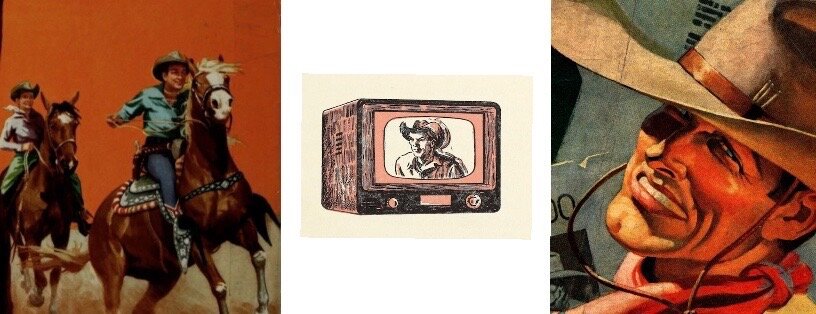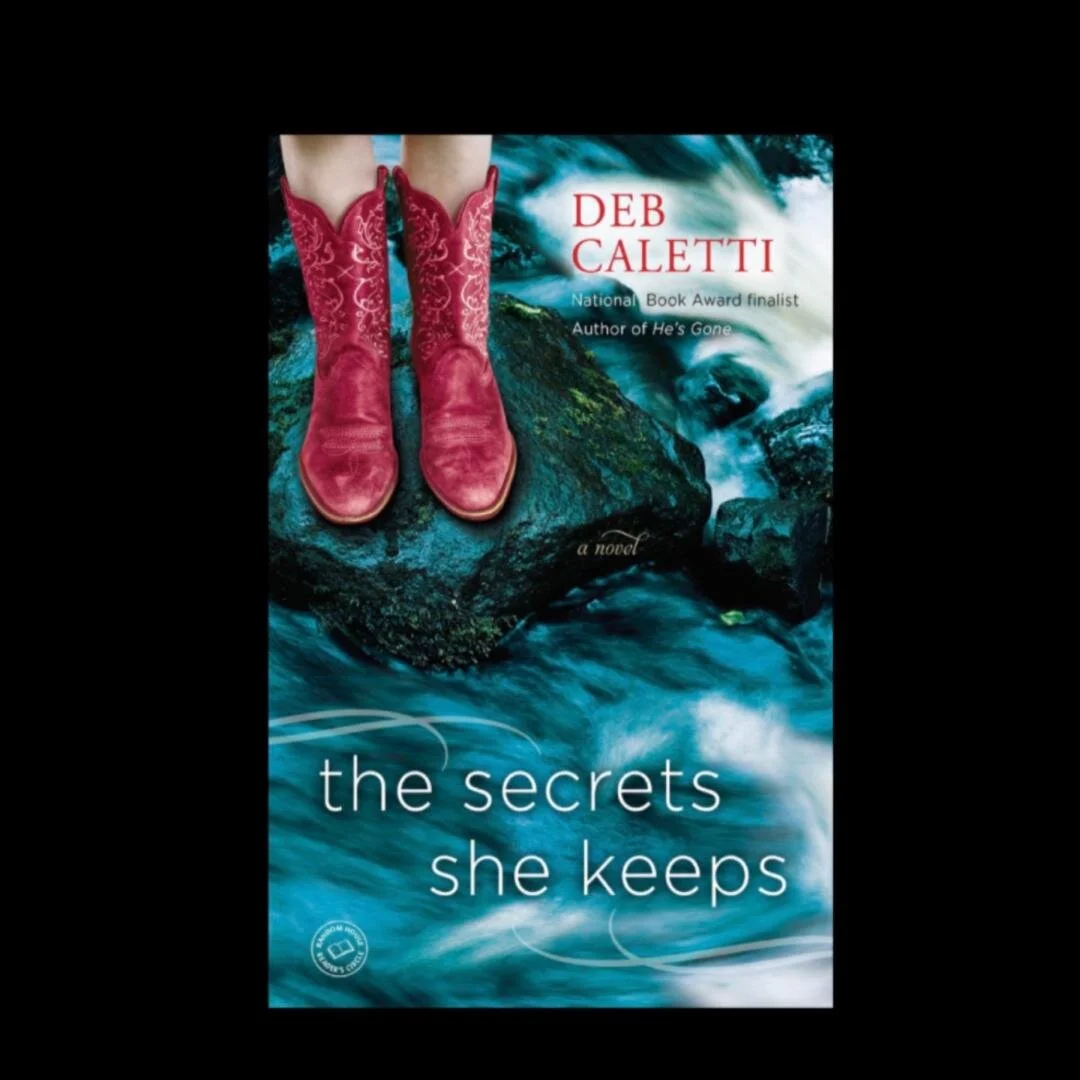
The Secrets She Keeps
“[Deb] Caletti once again combines interesting characters, pitch-perfect dialogue, and an intriguing plot to tell a deeply memorable story. Her latest is a thoughtful exploration of love and marriage and the power of family and friendship to help along the way.”
—Booklist
“Past, present, and the strength of female friendship blend in a work billed for the Kristin Hannah–Liane Moriarty crowd.”
—Library Journal
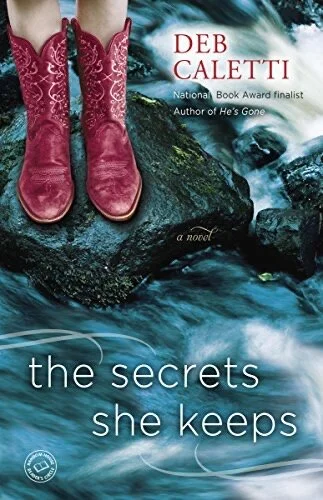
From bestselling author Deb Caletti comes a beautiful and profound novel of three women coming to terms with love and marriage—sure to move and delight fans of Kristin Hannah, Liane Moriarty, and Anna Quindlen.
“You don’t grow up on a divorce ranch and not learn to take a vow seriously.”
When Callie McBride finds a woman’s phone number written on a scrap of paper her husband has thrown away, she thinks that her marriage is over. Callie flees to Nevada and her Aunt Nash’s Tamarosa Ranch, where she’s shocked to see that the place of so many happy childhood memories is in disrepair. Worse, Aunt Nash is acting bizarrely—hoarding stacks of old photographs, burying a book in the yard, and railing against Kit Covey, a handsome government park ranger who piques Callie’s interest.
But Aunt Nash may prove to be saner than she seems once Callie pulls back the curtain on Tamarosa’s heyday—the 1940s and ’50s, when high-society and Hollywood women ventured to the ranch for quickie divorces and found a unique sisterhood—and uncovers a secret promise Nash made to her true love. Callie will come to see is that no life is ever ordinary. No story of love is, either.
“The first rule of marital success: Don’t marry crazy and don’t be crazy. ”
The Secrets She Keeps: The Six-Week Cure
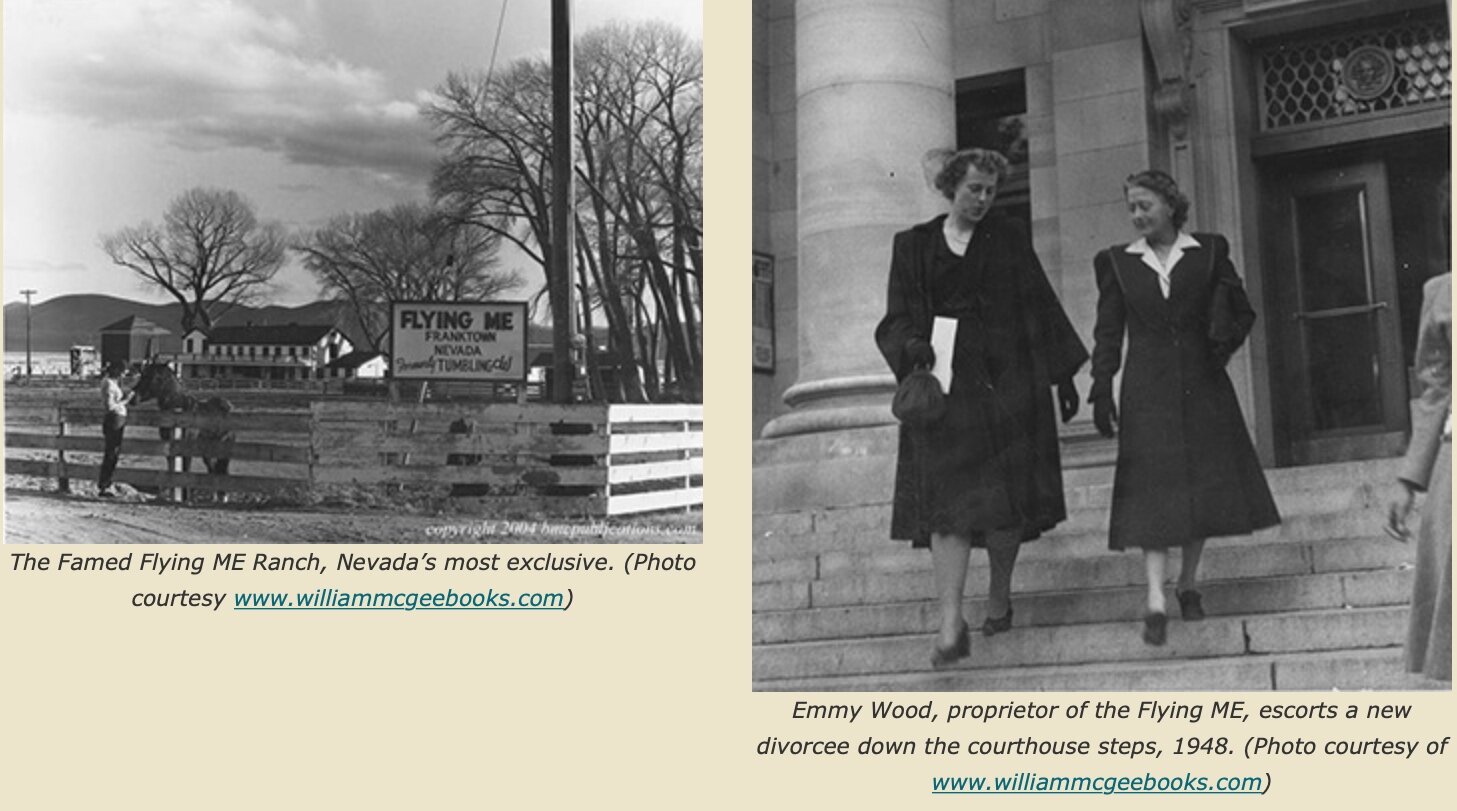
Maybe you saw the old Mad Men episode where Betty Draper goes to a divorce ranch. Or maybe you saw the classic film The Misfits, where Marilyn Monroe does. Or maybe, like me, you saw neither, and are as unfamiliar with those words as I was a few years ago when I came across them in a travel memoir. Divorce ranch? I had to know more. I looked up the phrase, and after I read about these places, I knew I had my next novel, the novel that would become THE SECRETS SHE KEEPS. Divorce ranches, I learned, flourished in Nevada in the 1930’s to early 1950’s, when divorces were difficult to get elsewhere. Women (usually high society or Hollywood types) would stay at the ranches for six weeks to establish residency, so they then might be free to get a divorce in the state that made it possible.

A stay at the ranch was sometimes called “The six-week cure,” and such a “cure” was a bold move in a time when divorce carried great shame. Often, a stay at one of the ranches also resulted in rebellious behavior in an unfamiliar locale. There was a new sense of freedom. Aided and abetted by the ranch matrons and cowboy “dude wranglers,” the women often underwent what Walter Winchell called a “Reno-vation.” While at the ranch, they would ride horses, go to town, go on a pack trip, hang out together, or ski, but they’d also drink, dance, flirt with cowboys, or even have an affair with one. Occasionally, the women brought their children along. Occasionally, a man would arrive for the six-week stay instead. And occasionally, the women brought a “spare” – the next husband they planned to marry at the wedding chapel right next to the courthouse after getting their divorce. But generally, the women came alone, frequently bonding to the other woman there, to the ranch staff, and to the land (or doing the opposite – hating all) as they moved toward their new lives.
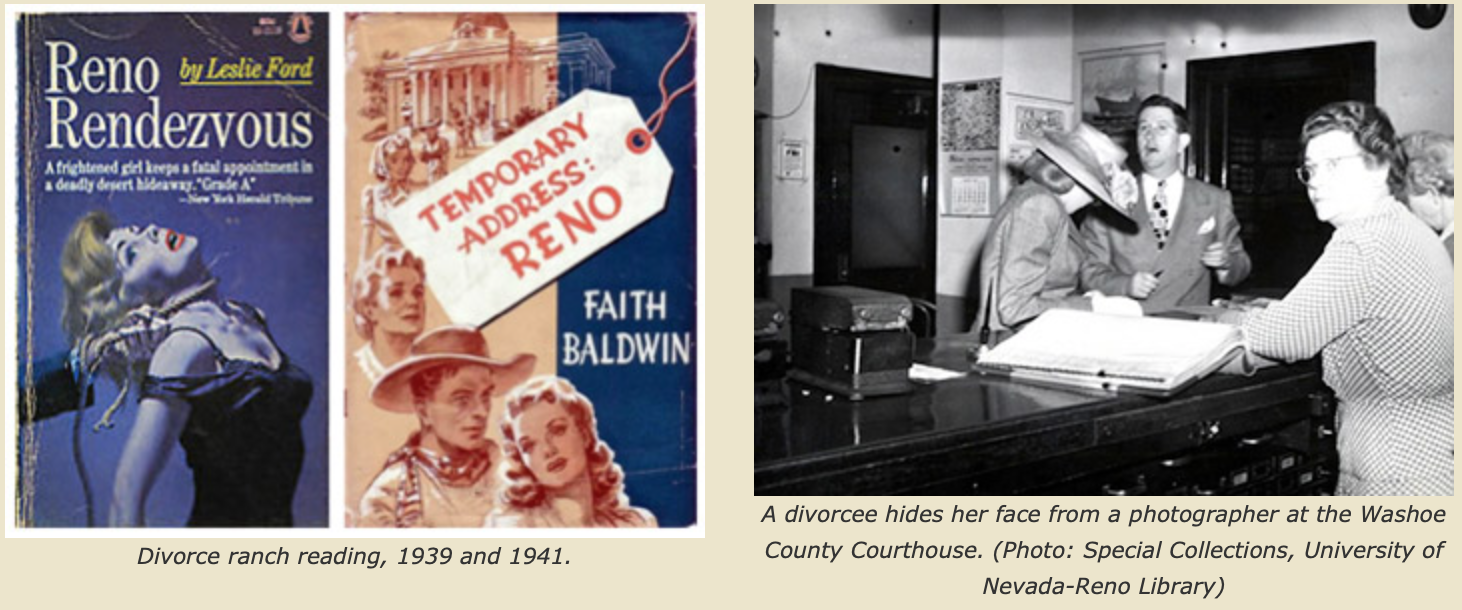
When I learned about the ranches, and understood the transformative experiences that were had there, I was intrigued. But when I realized how little there was about them in the popular culture, I had one of those writer-moments where your heart beats fast and you can’t wait to get started. Here was all of my favorite stuff in one beautiful, dusty, desert locale: marriage, heartbreak, women of varying ages attempting to understand themselves and their relationships. And here was a period in the history of marriage and divorce that was unknown to many contemporary women.
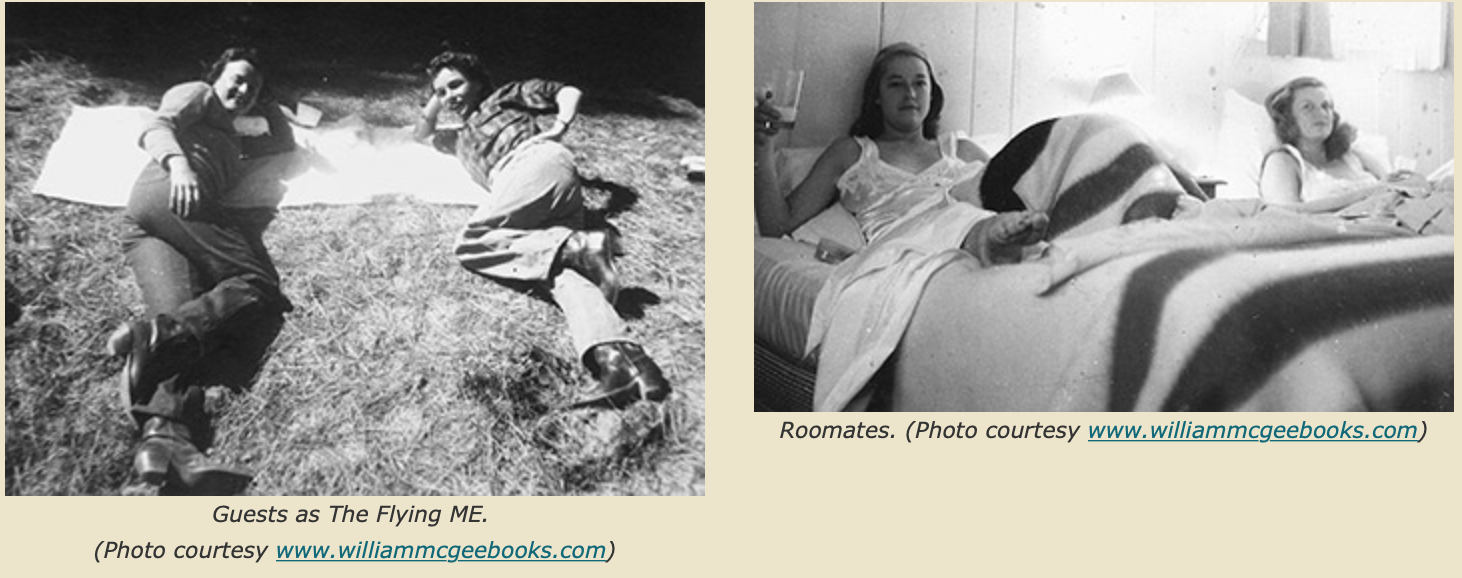
Bringing that time period to life, though, was trickier than I’d anticipated, because of exactly what I’d found so thrilling – how little there was out there about the ranches. Luckily, I discovered The Divorce Seekers, a stunning coffee table volume of photos and memories by a former dude wrangler at the famed Flying M.E. ranch, Bill McGee. The images – with their smoky, black-and-white, retro allure – are what brought the time and place alive for me so that I could bring them to life in the novel. Not only was it an invaluable resource for information on day-to-day life on a divorce ranch, it also set the mood. I’d open the book to an image of two sleepy roommates in the middle of their Reno Cure, wearing silky chemises, drinks in hand, or to a photo of “the gals” in their party-night finery, and I’d be just where I needed to be. Music of the time occasionally helped, too. As well, I researched the bestsellers of those years written by women, so I could get a feel for the female voices of the time. Sometimes I’d read a page or two in order to “get into character” so to speak.
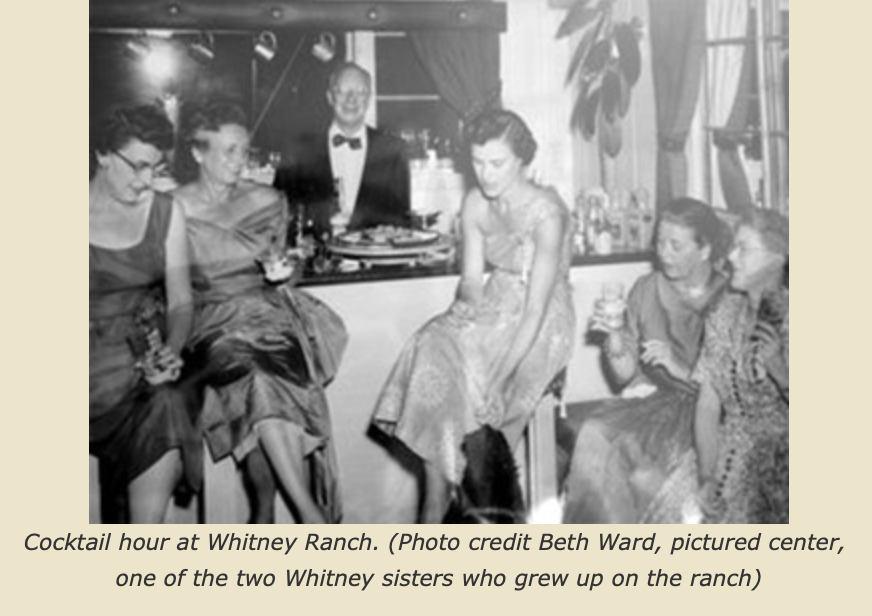
I was surprised how wild it all got on the ranches. When you think of that time period, you imagine a (literally) more buttoned-up experience, but no. The sex with cowboys, the drinking, the letting loose – it all sounds a bit film-version-cliché, but was very much the truth. Each generation thinks they’ve invented sex and rebellion, but we seem like over-sharing novices in comparison. Their experiences were not splayed out on every television and computer screen, and the language around it was discreet and even somewhat coy, but often these were no trips to the convent.
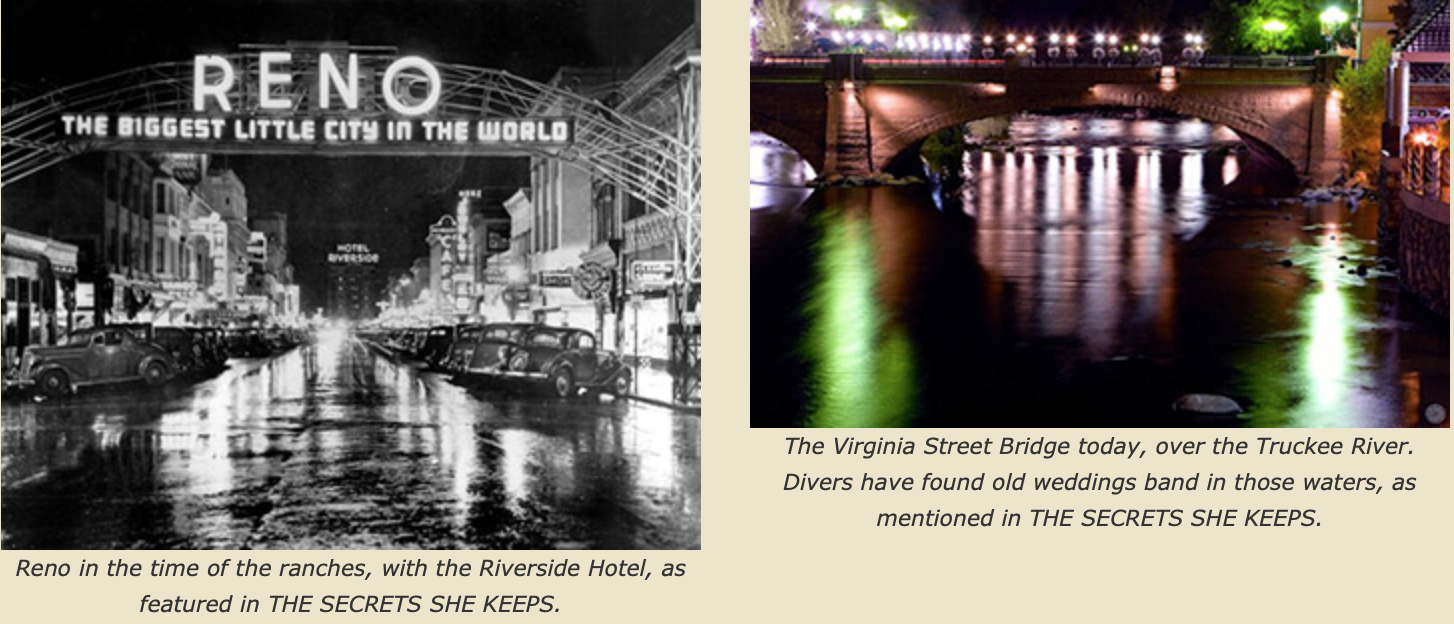
What also surprised me – and what became extraordinarily important thematically to the book – was how timeless our struggles are in terms of love. I could see the storylines repeating over the generations. We battle the same old things they did – bad choices, infidelity, abuse, career versus marriage conflicts, intruding parents. We move on too fast after a breakup; they’d go from the courthouse to the marriage chapel. We’re intrigued and tempted by a life not like ours; they’d buy ranch wear and try to bring home a cowboy. We’ve been taken (or we take); we’re endlessly hopeful (or fed up and jaded); we fall for the wrong person (or, finally, the right one). And so it was then. In THE SECRETS SHE KEEPS, the circular storyline and the mirror images that begin and end each chapter aim to say this: In terms of love and relationships, it is always “Here we are, all over again.”
“There, I was hit again with a feeling I’d had rather frequently as of late. Deep in the night, or even in broad daylight, a sense of the transitory would abruptly arise, shocking me, slapping my clueless self with the truth of my own age and how much time had already passed, and so suddenly too, it seemed. It would hit hard. And it made me want to keep hold of everything and to toss it away. How could you even talk about that? What were the words for it? I just didn’t know where it all went and how it went that fast. What we lost over a lifetime seemed so great.”
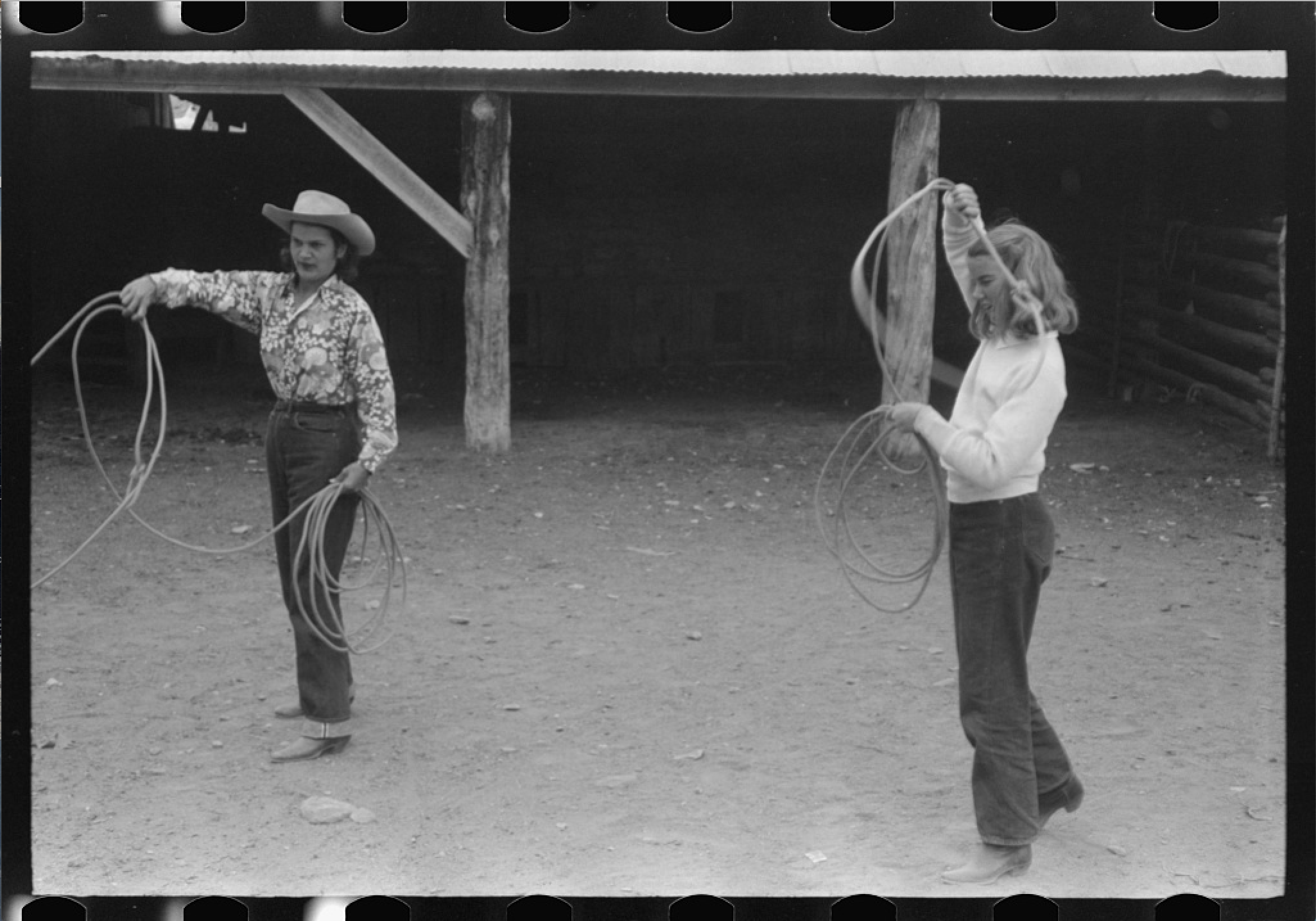
The Secrets She Keeps: A Conversation with Deb Caletti
Random House Reader’s Circle: What gave you the idea to write a story centered on the “Reno cure” and divorce ranches of the mid-20th century? Your portrayal of Tamarosa Ranch and the women who stayed there is so vivid, dazzling and authentic. How did you go about bringing this place and this era to life and from where did you draw your inspiration? Did you do anything specific to transport yourself into that world?
Deb Caletti:
A few years ago, I came across a single line in a book that mentioned a “divorce ranch.” I’d never heard the term before, and out of curiosity, I looked it up. When I learned what they were, and understood the transformative experiences that were had there, I was intrigued. But when I realized how little there was about them in the popular culture, I had one of those writer-moments where your heart beats fast and you think: This. Here was all of my favorite stuff in one beautiful, dusty, desert locale: marriage, heartbreak, women of varying ages supporting each other, and attempting to understand themselves and their relationships.
Bringing it to life, though, was trickier than I’d anticipated, because of exactly what I’d found so thrilling – how little there was out there about the ranches. Luckily, I discovered The Divorce Seekers, a stunning coffee table volume of photos and memories by a former dude wrangler at the famed Flying M.E. ranch, Bill McGhee. The images – with their smoky, black-and-white, retro allure - are what brought the time and place alive for me so that I could bring them to life in the book. Not only was it an invaluable resource for information on day-to-day life on a divorce ranch, it also set the mood. I’d open the book to an image of two sleepy roommates in the middle of their Reno Cure, wearing silky chemises, drinks in hand, or to a photo of one of “the gals” in her party-night finery, and I’d be just where I needed to be. Music of the time occasionally helped, too. As well, I researched the bestsellers of those years written by women, so I could get a feel for the female voices of the time. Sometimes I’d read a page or two in order to “get into character” so to speak.
RHRC: What’s the most surprising thing you learned about life on a divorce ranch?
D.C.:
I was surprised how wild it all got on the ranches. When you think of that time period, you imagine a (literally) more buttoned-up experience, but no. The sex with cowboys, the drinking, the letting loose - it all sounds a bit film-version-cliché, but was very much the truth. Each generation thinks they’ve invented sex and rebellion, but we seem like over-sharing novices in comparison. Their experiences were not splayed out on every television and computer screen, and the language around it was discreet and even somewhat coy, but these were no trips to the convent.
What also surprised me - and what became extraordinarily important thematically to the book - was how timeless our struggles are in terms of love. I could see the storylines repeating over the generations. We battle the same old things they did – bad choices, infidelity, abuse, career versus marriage conflicts, intruding parents. We move on too fast after a breakup; they’d go from the courthouse to the marriage chapel. We’re intrigued and tempted by a life not like ours; they’d buy ranch wear and try to bring home a cowboy. We’ve been taken (or we take); we’re endlessly hopeful (or fed up and jaded); we fall for the wrong person (or, finally, the right one). And so it was then. It was this baseline that led me, in part, to using the mirror images that begin and end each chapter. Hopefully, those brief repetitions underscore the idea that here we are, all over again.
RHRC: The Secrets She Keeps stars a true ensemble cast of women, each startlingly unique but all equally real. Was it difficult to create so many different, dynamic personalities and have them all sharing space, or did they come to you and interact with each other naturally?
D.C.:
Ensemble casts are something I like to do as a writer. It’s a challenge, and I think the varying perspectives bring layers to a story. I had an ensemble cast in two of my young adult novels, Honey, Baby, Sweetheart (in which a young girl and her mother go on a road trip with a group of old people to reunite a pair of geriatric lovers), and The Secret Life of Prince Charming (in which a young woman and her sisters return objects their father has stolen to every woman he’s ever been in love with). So, I’ve had experience managing those numbers before. Essentially, a character must sound like him or herself, and this is true whether you’re writing one or twenty. I don’t find this to be particularly difficult. If you think about your extended family all sitting around a dinner table, you realize how different each individual sounds. In addition to what they say and how they say it, Mom and Aunt so-and-so dress like opposites, and while the uncles are both hard-headed, one still wears his class ring, and the other has that weird beard and bad habit of interrupting.
RHRC: Can you speak to the experience of writing a dual narrative that has one foot in the past and one in the present? What were the most challenging and rewarding aspects of that process? Was it ever hard to switch gears from one storyline to the next?
D.C.:
The switching itself was rewarding - going back and forth brings a freshness and energy to the work. It’s similar to the experience of reading alternating chapters, where you’re disappointed to leave the first set of characters, but are eager to see what’s happened with the others since you last left off. I write chronologically, so sometimes that means waiting to write a big scene I’m looking forward to, or, in this case, waiting to get back to that exciting event in the past or present. Switching can provide tension and momentum for a reader, but it can do the same for a writer. And natural momentum makes a book a joy to write.
In terms of challenge, the past/present switching made for a ton of research. It was akin to writing a research-heavy contemporary novel and a historical one. When you go back into the past, every little thing must be considered and checked – each item of clothing, every phrase, every piece of furniture and automobile. Kitchen supplies! Hair products! Restaurants in a city! Music! What kind of gun would they have had at the ranch then? When did cars first get radios? Was a certain slang expression used yet? Which hat did a man wear for work, and which for dress? This brings us back to the rewards, though, because I learned about divorce laws through time, and obstetric practices, and the fact that ambulances were still not commonplace in rural areas then. I played virtual dress-up with the many beautiful outfits I discovered, and drooled (or cringed) over the food of the time period. I am still seriously curious about those greengage plums packed in sugar-sweetened brandy.
RHRC: The mustangs play a huge role in the book, not only in terms of their sheer majesty, but also their plight and the need to preserve and protect the land they inhabit. Are these larger issues something you already had a vested interest in exploring when you set out to write this book, or did that interest develop as you dug deeper into your research? Have you ever seen the mustangs running, yourself?
D.C.:
This may sound hugely disappointing and unromantic, but like Callie, I have no experience with horses. I’ve never really ridden one, and prior to this book, knew little about them. I’ve never been to a ranch, and have only been to Nevada once, in the back seat of the car with my parents when I was seven. As a writer, I often think about Lilly Tuck’s speech at the National Book Awards the year she won (and the year I was a finalist for Honey, Baby, Sweetheart). Her book was “The News from Paraguay,” and she began her speech by saying that she had never been to Paraguay, didn’t know much about Paraguay, and didn’t even really care to visit Paraguay. While I’d love to spend time on a ranch and was fascinated by all I learned, I understand what she meant. The adage urges writers to, “Write what you know,” but if we did, there’d be many novels about us sitting home alone, pecking at the keyboard. Or else, reading online reviews and becoming crippled with self-doubt.
That said, when searching for the storyline, themes, and symbols that would bridge the two narratives, the mustangs were a natural choice. Campaigns to save the mustang began just before the book does, in 1950, when Velma Bronn Johnston (Wild Horse Annie) of Washoe County, became involved in the campaign to save the wild horses after following a truck loaded with horses and dripping blood on its way to a slaughterhouse. (Yes, a certain scene in the book is a nod to her). In 1951, photographer Gus Bundy also began shooting images that became instrumental in changing gathers by airplane. But in addition to lending historic accuracy, the horses are a physical representation of love itself: passionate, messy, unpredictable, and stunning. The complicated questions that surround them, the lack of clear answers, was also symbolically on the mark.
I may not have known anything about the mustangs before I began, but I developed a great respect for them and for the individuals on both sides of the question, particularly the land managers who must consider every corner of the issue. I was astounded at the care they take to balance the interests of the land (and the other living things on it), with the some fifty thousand wild horses and burrows currently living in the western states.
RHRC: Callie is awed and humbled by her interactions with nature while exploring the Washoe Lake area, which lends such perspective to her life in Seattle. Living in Seattle yourself, do you find this reflects your own experience in any way? Do you prefer a city existence or the “of-the-land” lifestyle that Kit leads, or do you strive for more of a balance?
D.C.:
Callie’s observations are mostly part of her personal process, where she eventually learns that you sometimes need to get out of your daily existence to appreciate the beauty of your daily existence. Still, I think there’s some truth to the differences she notices, in terms of the biking techies, and hipster baristas, and self-aware food versus “…life like that, the one going on right there right then, men in cowboy hats, men with silver belt buckles, men with horses and guns.” We are very connected to nature and the outdoors here, too, but sometimes there’s an affected quality to it, a persona that’s worn along with all the right clothing from REI. Ranch life seems more straightforward, and the relationship to the land more pragmatic. That said, it’s also true that you’ll find some of the most stunning, breathtaking parts of this country in the Northwest, and we who live here do our best to appreciate that fact.
The city-or-not dilemma has always been large for me. The idea of sprawling acres of land and a small town has huge appeal. I used to live in a house on a salmon-running creek at the foot of a mountain before moving to the city when I remarried. I loved being near water, trees, and creatures. (Though I could’ve passed on the bear and the cougars.) I adored bumping my Jeep along the rugged dirt road, reveled in the awareness of seasons and the perspective nature brings. I still long for miles of windswept dunes, or a herd of cattle with room to roam, or a dock on a remote lake. But there is also the matter of little-black-dress literary parties, great restaurants, and the need for the nearness of a library. The perfect life would be a pair of old work boots next to the heels.
RHRC: Hadley keeps a saucer of foil-wrapped confections by her typewriter to “tempt the muse.” As a writer, do you have any habits, processes or, like Hadley, treats that get your creative juices flowing?
D.C.:
Hmm. Wonder where I got that? I confess that I’ve gone beyond the saucer to an actual drawer. Occasionally, a little self-bribery is useful. I usually start the writing morning with strong coffee and a shortbread cookie, the kind in the red plaid box that are all butter, glorious butter. Other treats in the drawer – Red Vines, Hot Tamales, chewy butterscotch, a bit of good chocolate. Full disclosure: I considered lying when answering this question.
RHRC: Nash and Lilly bond through the trading of beloved books. In that moment, Lilly asks, “‘Don’t you wish you could live inside a book sometimes?’” What book(s) would you live inside if you could?
D.C.:
A Moveable Feast would work nicely. Paris in the 1920’s, with Ernest Hemingway and pals like James Joyce, Ford Maddox Ford, Gertrude Stein… F. Scott Fitzgerald reading Hemingway the first draft of The Great Gatsby at their neighborhood café, La Closerie des Lilas… Ahh. I’m also drawn to the books like Under the Tuscan Sun, where a woman goes to a foreign country, remodels some crumbling villa, makes friends with villagers while walking her charming dog, all the while eating fabulous food.
RHRC: Of all the women you’ve brought to life in this novel, which would you say most resembles yourself? Or who would you most like to resemble? Who would be your partner in crime if you were to spend time at the Tamarosa Ranch?
D.C.:
Almost every character has a bit (or more) of the author in them, I think. Callie and Shaye reflect my own Yin/Yang: settled and restless, steady and unsteady, cautious and occasionally heedless. I have the aspirations of Hadley, and I’ve had (past tense) the naiveté of Ellen and Lilly’s unfortunate taste in men. I have Nash’s leanings toward solitude and open air, her book love, and her appetite. I’d most like to take on her realistic, calm worldview, though, and the strength she’s developed over her years. Veronica is least like me, and therefore, probably the one I’d want as a partner in crime. During a Six-Week Cure, you’d need a Veronica to encourage a little mischief. And to push you toward the life that’s truly yours.
“Those are such beautiful words aren’t they? Happy ending?” Lilly says. They are. They so are. But after all she’s seen, Nash doesn’t know if she believes in those particular words. She believes in something intricate and thorny, she thinks then. What she believes is that the story goes on.”
